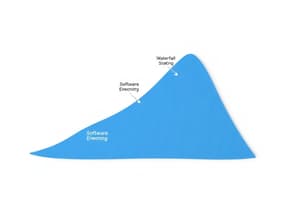Podcast
Questions and Answers
What characterizes traditional life cycle models in system development?
What characterizes traditional life cycle models in system development?
- They are based on a circular feedback process.
- They allow for flexible changes at any phase.
- They prioritize continuous integration throughout development.
- They follow a linear or sequential process. (correct)
Which of the following models emphasizes testing and verification at every development stage?
Which of the following models emphasizes testing and verification at every development stage?
- Incremental Model
- Waterfall Model
- Iterative Model
- V-Model (correct)
Which model is designed to deliver portions of the project incrementally?
Which model is designed to deliver portions of the project incrementally?
- Iterative Model
- Prototyping Model
- Incremental Model (correct)
- Waterfall Model
What is a core aspect of the Iterative Model?
What is a core aspect of the Iterative Model?
What does the Prototyping Model primarily aim to achieve?
What does the Prototyping Model primarily aim to achieve?
What is a primary focus of modern life cycle models in software development?
What is a primary focus of modern life cycle models in software development?
Which method prioritizes speed and user involvement in its development process?
Which method prioritizes speed and user involvement in its development process?
What is the purpose of the Scrum framework within the Agile model?
What is the purpose of the Scrum framework within the Agile model?
How does the Kanban methodology improve efficiency?
How does the Kanban methodology improve efficiency?
What combination does DevOps aim to enhance within software development?
What combination does DevOps aim to enhance within software development?
Which model is characterized by combining iterative development with a risk-driven approach?
Which model is characterized by combining iterative development with a risk-driven approach?
What distinguishes modern life cycle models from traditional ones?
What distinguishes modern life cycle models from traditional ones?
Why are modern life cycle models important in today's software development?
Why are modern life cycle models important in today's software development?
What is the primary focus of the Planning phase in the SDLC?
What is the primary focus of the Planning phase in the SDLC?
Which phase in the SDLC involves generating and comparing alternative designs?
Which phase in the SDLC involves generating and comparing alternative designs?
In which phase is the information system actually built and put into operation?
In which phase is the information system actually built and put into operation?
What distinguishes logical design from physical design in the SDLC?
What distinguishes logical design from physical design in the SDLC?
What is the focus of the Maintenance phase in the SDLC?
What is the focus of the Maintenance phase in the SDLC?
Why are the phases of the SDLC not necessarily sequential?
Why are the phases of the SDLC not necessarily sequential?
What is the primary deliverable of the Analysis phase?
What is the primary deliverable of the Analysis phase?
What does the Design phase specifically convert into logical and physical specifications?
What does the Design phase specifically convert into logical and physical specifications?
Flashcards
Traditional Life Cycle Models
Traditional Life Cycle Models
A structured approach in software development that follows a linear process with defined stages. It emphasizes planning, design, implementation, testing, deployment, and maintenance.
Waterfall Model
Waterfall Model
A linear model where each phase, such as requirements, design, implementation, testing, deployment, and maintenance, must be completed before moving to the next.
V-Model
V-Model
An extension of the Waterfall model that emphasizes testing and verification at every development stage. It aims to ensure quality and correct issues early on.
Incremental Model
Incremental Model
Signup and view all the flashcards
Iterative Model
Iterative Model
Signup and view all the flashcards
Rapid Application Development (RAD)
Rapid Application Development (RAD)
Signup and view all the flashcards
Agile Model
Agile Model
Signup and view all the flashcards
Scrum
Scrum
Signup and view all the flashcards
Kanban
Kanban
Signup and view all the flashcards
DevOps
DevOps
Signup and view all the flashcards
Modern Life Cycle Models
Modern Life Cycle Models
Signup and view all the flashcards
Spiral Model
Spiral Model
Signup and view all the flashcards
SDLC (System Development Life Cycle)
SDLC (System Development Life Cycle)
Signup and view all the flashcards
Planning and Selection
Planning and Selection
Signup and view all the flashcards
Analysis
Analysis
Signup and view all the flashcards
Design
Design
Signup and view all the flashcards
Implementation
Implementation
Signup and view all the flashcards
Maintenance
Maintenance
Signup and view all the flashcards
Flexibility in SDLC
Flexibility in SDLC
Signup and view all the flashcards
Phase Outcomes
Phase Outcomes
Signup and view all the flashcards
Study Notes
Chapter 2: System Development Life Cycle Models
- System Analysis and Design Fundamentals (CSC 1403)
Learning Objectives
- Identify the traditional models of SDLC
- Explain the differences of systems life cycle models used in system development
- List all the stages of SDLC
2.1 Traditional Life Cycle Models
- The term "Traditional Life Cycle Models" refers to structured approaches for software development and system engineering.
- These models are linear or sequential, frequently having clearly defined stages.
- They are used to plan, design, implement, test, and maintain projects.
2.1.1 Examples of Traditional Life Cycle Models
- Waterfall Model: A linear approach where each phase (Requirements, Design, Implementation, Testing, Deployment, and Maintenance) must be completed before moving to the next.
- V-Model (Validation and Verification): Extends the Waterfall model by emphasizing testing and verification at every development stage.
- Incremental Model: Divides the project into smaller segments for incremental development and delivery.
- Iterative Model: Focuses on refining processes through repeated cycles to improve the system at each iteration.
- Prototype Model: Involves creating an initial prototype to gather user feedback and refine requirements.
2.1.2 Waterfall Model
- A linear, sequential approach
- Each phase must be completed before proceeding to the next phase
- Stages: Requirement Analysis, System Design, Implementation, Testing, Deployment, and Maintenance
2.1.3 V-Model
- Extends the waterfall model
- Emphases Verification and Validation at different stages of the development process—during planning, design, and implementation
- Verification phases test each output in relation to inputs/requirements
2.1.4 Incremental Model
- Breaks down a project into smaller increments (segments)
- Each increment can be developed and delivered incrementally, allowing users to get value early on
2.1.5 Iterative Model
- Repeated cycles to refine and improve the system with feedback
- Focuses on refinement and improving the system at each iteration
2.1.6 Prototype Model
- Creates an initial prototype
- Used to gain user feedback and refine the requirements.
2.2 Modern Life Cycle Models
- Modern approaches to software development emphasize flexibility, adaptability, and iterative progress, catering to dynamic business needs and evolving technologies.
- They contrast to traditional models by focusing on continuous improvement, collaboration, and faster delivery.
2.2.1 Examples of Modern Life Cycle Models
- Rapid Application Development (RAD): Emphasizes speed, flexibility, and iterative development by prioritizing user involvement
- Agile Model: A flexible and iterative method that promotes collaboration, customer feedback, and rapid releases.
- Scrum: A subset of Agile focused on short development cycles (sprints) and defined roles.
- Kanban: A lean methodology that emphasizes visual workflows and limits work-in-progress to improve efficiency.
- DevOps: Combines development and operations to enhance collaboration, automate processes, and enable continuous delivery and integration.
- Spiral Model: Combines iterative development with a risk-driven approach, passing repeatedly through planning, design, build, and testing phases.
2.3 Overview of SDLC Stages
- Traditional methodology to maintain, develop, and replace information systems
- Consists of five phases: Planning, Analysis, Design, Implementation, and Maintenance.
- Phases are not necessarily sequential
- Each phase has specific deliverables and outcomes
- Individual companies may customize life cycles.
- Focus is on the stages of the development process, and details on these stages follow.
2.3.1 Planning
- The first phase of the SDLC in which an organization’s total needs for an information system are identified, prioritized, and arranged.
2.3.2 Analysis
- Studies current procedures and information systems, determines requirements, generates alternative designs, compares alternatives, and recommends one as the best.
2.3.3 Design
- Describes the recommended solution in logical and physical system specifications
- Defines functional features of the system independently of platform.
- Physical design translates logical specifications to tech-specific programming.
2.3.4 Implementation
- System coding, testing, installation, and ongoing support within the organization.
2.3.5 Maintenance
- The final phase of the SDLC, where the system actively maintains repairs and improvements based on user needs, reflecting evolving conditions.
Studying That Suits You
Use AI to generate personalized quizzes and flashcards to suit your learning preferences.




